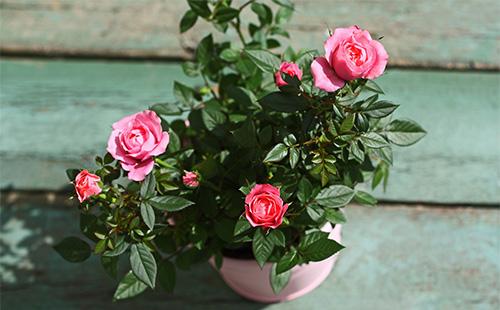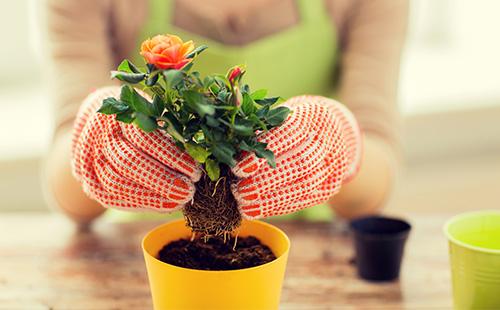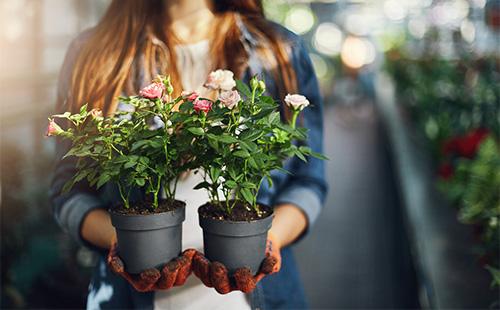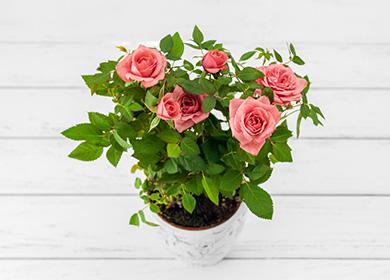The content of the article
Rose is a popular potted indoor flower, loved by many gardeners for the variety of colors and shades of the flowers and the delicate aroma. Of course, I want to keep my beloved correctly so that she continues to please even more, therefore the owners of the beauty are often interested in the nuances of care - how often a decorative rose blooms, what to do with a rose, if it has blossomed, how to care for a plant in autumn, why leaves turn yellow, photos of pests on leaflets, and other small and not very problems.
In terms of beauty and aroma, indoor roses are not inferior to garden varieties. It is not easy to grow them - you need to strictly adhere to agricultural technology, protect from pests. But if you follow the advice of experienced gardeners, you can plant a real rose garden on the windowsill.
Description and Features
Belong to the vast family of Rosaceae. Indoor varieties do not exceed 0.5 m in height. They are climbing, groundcover, and standard. Most often, compact bush varieties are found.
Leaflets carved, matte or glossy. Flowers vary in size - are small and large. Color from snow-white to dark burgundy. The birthplace of dwarf roses is China. Some varieties bloom almost year-round; others require a short dormant period.
Popular views
Varieties specially adapted to artificial conditions are grown in apartments. They are easier to adapt to low humidity, stable temperature without seasonal differences. The following varieties are especially popular.
- Bourbon. It has a pronounced rest period. Drops leaves for the winter. New leaves appear in mid-spring. It blooms usually from July to December. Bush high for a room variety - reaches half a meter. The flowers are large.
- Tea Room. Compact bush with delicate, fragrant flowers. The leaves are light green, densely cover the stem.
- Repair. The main difference from other species is the ability to bloom year-round without a rest period. The color is varied, the size of the flowers is medium. The buds are shaped like a glass. It is considered a relatively unpretentious variety.
- Bengal. Unpretentious, compact bushes about 20 cm high. Leaves are small. The flowers are large, often double. The color is mainly red or pink. Bloom almost year-round.
- Chinese. Very lush bushes densely sprinkled with small flowers.
- Polyanthus. The height of the bush reaches 30 cm. The flowers are small, but completely cover the bush. The aroma is very weak. It blooms from mid-summer to almost winter.
Choice of flower and action after purchase
A common situation is that a lush, flowered bush of a house recently bought at a store begins to wither away quickly and completely dries out. What is the reason? How to choose and help the plant adapt?
2 criteria
It is recommended that you take the rose seriously. Two basic rules will help you choose a good, healthy plant.
- Appearance. Choose a plant that looks strong and healthy. If there are yellow, dry, spotty leaves on the bush - it is better not to take such a rose. Inspect the inside of the leaves for pests, pay attention to the condition of the soil. Find out when the plant went on sale. The less time the flower spent in the store, the better.
- Flowering stage. Prefer a bush with buds rather than blooming flowers. The rose, which is still about to bloom, did not have time to expend a lot of energy.
First events
Most often, roses die due to an improperly organized adaptation period. It includes a number of activities.
- Transfer. Drainage holes at the bottom and drainage are required. It is better to use a special primer for roses - it is quite difficult to achieve the optimal ratio of nutrients by mixing the components. Transplanted by transshipment method.
- Pruning. All buds are cut. If you do not do it now, the rose will spend a lot of energy on flowering and die as a result.
- Quarantine. Put the bush in a sun-protected, warm, well-ventilated place separate from other plants. To prevent the appearance of insects, you can spray with a weak solution of any insecticide.

Basic care
Rose - capricious, demanding microclimate and care. To achieve the preservation of decorativeness and stable, friendly flowering is possible only by observing the basic rules of care.
- Temperature. In summer, the most favorable temperature is 16-25 ° C. Roses do not like excessive heat. In the summer, it is allowed to take out the flower on the balcony and even plant it in the open ground. In winter, the optimum temperature is 15-17 ° C.
- Lighting. Roses love bright lighting, but react negatively to direct sunlight. They are kept on the east and south-east windows, in the heat they shade. From time to time, the pot is expanded. In winter, the lack of light is filled with artificial lighting.
- Watering. As the surface dries up. Watered under the root with cool water. Abundant watering is recommended, followed by pouring excess liquid from the pan. In the heat, water up to two times a day. In winter, watered sparingly and rarely - the soil is allowed to dry well.
- Humidity. Slightly increased humidity favorably affects the appearance of the rose. Spraying is a mandatory procedure. Additionally, you can spray the air in the room, put a pot of roses in a tray with wet expanded clay or pebbles.
- The soil. Soil acidity is neutral. A mixture of humus and turf with the addition of sand is allowed. But it is better to give preference to ready-made primers for roses.
- Top dressing. Fertilizers are often applied at intervals of one week or a little longer. The alternation of mineral and organic fertilizers is recommended. In winter, they feed very moderately or do not feed at all.
- Transfer. Transplanted when the root system grows strongly or the soil becomes unusable. The roots of the rose are very brittle - it needs to be transplanted extremely carefully.
Pruning
Trimming is necessary to form a neat bush and improve flowering. When performing cropping, a number of rules are followed.
- Certain shoots. First of all, all underdeveloped, weak, excess shoots are cut. There should be a few strong shoots with full wood. The shoots are cut, leaving six eyes. If the shoots are rather weak, fewer eyes are left.
- Time. Dwarf large-flowered roses are cut in the spring, leaving from three to five eyes. Varieties with small flowers are pruned harder - two to three eyes. This stimulates abundant flowering.
- Care after formation. Immediately after pruning, the rose is rearranged in a cool place. With the advent of the first leaves, the flower is rearranged in a warm, bright, sunny place, and usual care is resumed. Asymmetrical twigs periodically pinch.
Breeding
You can propagate only by cuttings. Rooting them is easier in the summer, not in the spring. With good care, young plants have time to bloom in the same year - in early autumn. But many roses, rooted in the summer, die in the winter due to the poorly developed root system.
Spring cuttings take root more heavily, but plants from them turn out to be more hardy, easily withstand wintering. You can root in water or directly in the ground.
Rooting in the ground
Several cuttings are cut at once, so that later it will be possible to select the strongest seedlings. The container is filled with nutrient soil. At a distance of about 10 cm from each other, finger recesses are made up to 4 cm. A little sand or vermiculite is poured into the hole. The tip of the handle is treated with a root stimulant, set it in the pit, the soil around is slightly compacted. Be sure to cover with a film to create a greenhouse effect. The greenhouse is aired from time to time, the soil is moistened from a spray bottle. The cuttings are also sprayed.
Rooting in water
Cuttings of roses easily let roots in the water. To accelerate the formation of roots in water, add a little preparation "Heteroauxin". For the prevention of decay of the cuttings - a tablet of activated carbon.
Despite the addition of coal to the water, the base of the cuttings sometimes rot. In this case, the tip is cut, the water is changed and the attempt to root is repeated. After root formation, seedlings are carefully transplanted into the ground.
Common diseases
Roses are very susceptible to disease. Any error in the care weakens the plant, increases the likelihood of a disease. The most common diseases and their treatment are described in the table.
Table - Indoor rose diseases and methods of treatment
| Title | Symptoms | Treatment |
|---|---|---|
| Powdery mildew | - White coating (powdery); - weakening of the plant | - Removing diseased shoots; - spraying with Topaz |
| Downy mildew | - Whitish velvety coating on the back of the sheet; - bright spots with a purple tint on the outside of the leaves | - Cropping; - spraying with fungicides (you need to alternate different drugs) |
| Spotting roses | Stains on leaves of different nature | - Frequent airing of the room; - decrease in air humidity; - removal of affected parts; - spraying with preparations containing copper |
| Rust of roses | - Reddish or dark brown pustules on the back of the leaf; - brown spots on the outside of the sheet | - Removal of all leaves with signs of damage; - spraying with Topaz fungicide; - regular airing of the room |
| Mold | - The appearance of mold on shoots, soil; - spots on the leaves; - rotting roses | - Reduced watering; - ventilation of the room; - use of fungicides |
| Bacterial cancer | - Yellow stripes on the leaves; - decay of the roots and bottom of the rose | The plant cannot be reanimated; it is destroyed at the first sign of illness. |
| Black spotting | - Black spots on the leaves; - drying and falling of leaves | - Pruning shoots to healthy tissue; - transplant with a complete replacement of soil and pot; - spraying with fungicides |

Errors of care
Most problems are due to improper care. If something is wrong with the rose, first analyze the conditions of detention and care. This will help the table listing the main problems and their possible causes.
Table - Problems in growing room roses and their causes
| Problem | Possible reasons |
|---|---|
| The rose does not bloom | - Untimely or incorrect pruning; - humidity below 40%; - irregular watering; - lack of nutrients; - lack of rest period for some species |
| Leaves turn yellow, turgor is lost | - Diseases of the roots; - drying of the soil; - lack of minerals |
| Local areas of dead tissue appear on the foliage | High concentration burn after treatment with chemicals |
| Leaves dry | - Drying of the soil; - too dry air; - pests |
| Branches grow actively, but no flowers | Rose overfed |
| Buds fall | - Drafts; - irregular watering; - moving roses during the set of buds; - a sharp change in conditions of detention; - thrips |
Signs of Nutrient Deficiency
Sometimes the loss of decorativeness is not associated with diseases and care errors. A number of symptoms indicate that the rose lacks a particular substance. Information on the signs of a lack of various minerals is given in the table.
Table - Mineral deficiency in roses
| Substance | Signs of Shortage |
|---|---|
| Phosphorus | - The color of the leaves is dark with a red tint; - violet-brown stripes along the edge of the leaves; - chopping leaves; - growth retardation of shoots; - lilac shade of petioles and leaf veins; - delayed flowering; - weak development of the root system |
| Potassium | - Yellowing of the edges of the leaves (green veins); - drying of the edges of the leaves; - chopping flowers; - reddish tint of young leaves; - with a pronounced deficiency, the gradual death of leaves and shoots |
| Magnesium | - bleached spots; - dark red and yellowish-red patches between the veins; - early fall of leaves; - the edges of the leaves are green |
| Iron (chlorosis) | - Yellowing of young leaves, starting from the edge; - along the veins a thin green stripe; - the leaves become almost white, fall off |
| Calcium | - Weakening of stems; - the death of peduncles, apical shoots; - slowing down the development of roots; - young leaves are twisted |
| Manganese | - Yellowing of leaves from edge to middle; - grown green edging along the veins; - unlike chlorosis, mostly middle-aged leaves suffer |
The lack of a specific mineral substance is compensated by the introduction of complex preparations with its high content.

Common pests
Significant harm to indoor roses is caused by pests. Aphids are common, scale shieldspider mite. Detailed information on pests is given in the table.
Table - Pests of indoor roses and ways to combat them
| Insect | Signs | Wrestling |
|---|---|---|
| Rose aphid | - Twisting shoots; - sticky discharge; - discoloration of damaged parts; - falling of leaves; - growth retardation | - Pruning of affected shoots; - triple washing with soapy water; - spraying with Actellik |
| Spider mite | - Pale dots on the leaves; - large whitish spots; - twisting and falling leaves; - thin web | The use of drugs "Actellik", "Fitoverm", "Vermitek" (alternate) |
| Thrips | - Silver spots, similar to strokes; - discoloration of the leaves; - shedding of pollen; - small holes in the petals | - Rinse roses with tar or green soap; - removal of severely damaged leaves; - spraying and watering with Confidor or Aktara |
| Rose sawfly | - Deformation of the leaves; - gnawing on the leaves; - slowdown | Spraying with Fufanol |
| Shield | - Brown, easily detachable plaques; - falling of leaves; - growth retardation | Use of any insecticidal drugs |
| Rose circadian | - Small white dots on the leaves; - marbling of leaves; - yellowing and falling of leaves; - in spring, small white larvae appear on the underside of the leaf | Treatment with insect acaricides "Aktara", "Aktellik" |
| Slobbering pennies | - Foamy discharge in the axils of the leaves; - rose wilting | Spraying with drugs "Actellik", "Aktara" |
To admire beautiful flowers all year round, several varieties with different flowering periods are planted simultaneously. This plant is perfect for room decor and as a gift.

